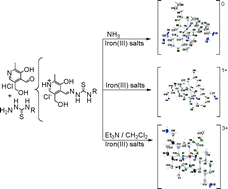Four novel mononuclear coordination compounds namely: [Fe(Hthpy)2](SO4)1/2·3.5H2O 1, [Fe(Hthpy)2]NO3·3H2O 2, [Fe(H2mthpy)2](CH3C6H4SO3)3·CH3CH2OH 3 and [Fe(Hethpy)(ethpy)]·8H2O 4, (H2thpy = pyridoxalthiosemicarbazone, H2mthpy = pyridoxal-4-methylthiosemicarbazone, H2ethpy = pyridoxal-4-ethylthiosemicarbazone), were synthesized in the absence or presence of organic base, Et3N and NH3. Compounds 1 and 2 are monocationic, and were prepared using the singly deprotonated form of pyridoxalthiosemicarbazone. Both compounds crystallise in the monoclinic system, C2/c and P21/c space group for 1 and 2, respectively. Complex 3 is tricationic, it is formed with neutral bis(ligand) complex and possesses an interesting 3D channel architecture, the unit cell is triclinic, P![[1 with combining macron]](https://www.rsc.org/images/entities/char_0031_0304.gif) space group. For complex 4, the pH value plays an important role during its synthesis; 4 is neutral and crystallises with two inequivalent forms of the ligand: the singly and the doubly deprotonated chelate of H2ethpy, the unit cell is monoclinic, C2/c space group. Notably, in 1 and 4, there is an attractive infinite three dimensional hydrogen bonding network in the crystal lattice. Magnetic measurements of 1 and 4 revealed that a rather steep spin transition from the low spin to high spin Fe(III) states occurs above 300 K in the first heating step. This transition is accompanied by the elimination of solvate molecules and thus, stabilizes the high spin form due to the breaking of hydrogen bonding networks; compared to 2 and 3, which keep their low spin state up to 400 K.
space group. For complex 4, the pH value plays an important role during its synthesis; 4 is neutral and crystallises with two inequivalent forms of the ligand: the singly and the doubly deprotonated chelate of H2ethpy, the unit cell is monoclinic, C2/c space group. Notably, in 1 and 4, there is an attractive infinite three dimensional hydrogen bonding network in the crystal lattice. Magnetic measurements of 1 and 4 revealed that a rather steep spin transition from the low spin to high spin Fe(III) states occurs above 300 K in the first heating step. This transition is accompanied by the elimination of solvate molecules and thus, stabilizes the high spin form due to the breaking of hydrogen bonding networks; compared to 2 and 3, which keep their low spin state up to 400 K.
![[1 with combining macron]](https://www.rsc.org/images/entities/char_0031_0304.gif) space
space 

 Please wait while we load your content...
Please wait while we load your content...